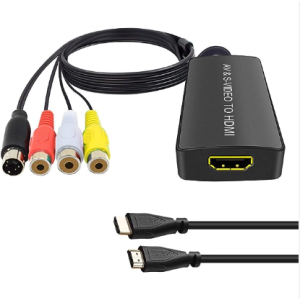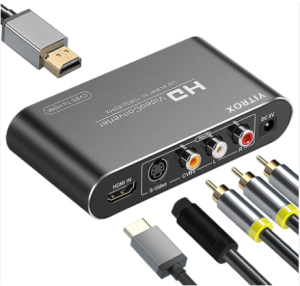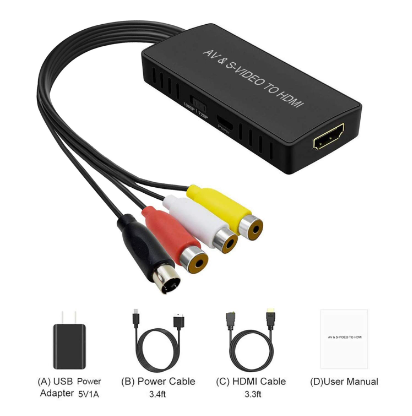S-Video To HDMI
In the ever-evolving world of technology, where new standards and formats emerge regularly, the need for seamless compatibility between older and modern devices becomes increasingly crucial. One such scenario involves the transition from S-Video to HDMI, where a reliable converter bridges the gap, enabling users to enjoy improved visual experiences. This article delves into the realm of S-Video to HDMI converters, highlighting the best options available in the market and exploring their benefits in enhancing visual quality.
The Evolution of Video Connectivity
Before delving into the specifics of S-Video to HDMI converters, it’s essential to understand the historical context of these two video connectivity standards.
S-Video, short for Separate Video or Super Video, emerged in the late 1980s as an improvement over the standard composite video connection. It aimed to provide better image quality by separating the video signal into two components: luminance (brightness) and chrominance (color). However, as technology advanced, S-Video began to fade from the mainstream due to the emergence of more advanced video standards like component video and HDMI.
High-Definition Multimedia Interface (HDMI) was introduced in the early 2000s as a revolutionary all-digital audio and video interface. HDMI offered superior quality, enabling the transmission of high-definition video and multi-channel audio through a single cable. This transition rendered older standards like S-Video obsolete, prompting the need for converters that could bridge the gap between legacy devices and modern displays.
S-Video to HDMI Converters: Bridging the Gap
S-Video to HDMI converters play a pivotal role in connecting older devices, such as VCRs, older gaming consoles, and camcorders, to modern high-definition displays like HDTVs and computer monitors. These converters function by converting the analog S-Video signal into a digital format compatible with HDMI inputs. This transformation not only ensures compatibility but also enhances the visual quality, making it possible to relive classic content with improved clarity and color representation.
Best S-Video to HDMI Converters
RCA to HDMI Converter
The RCA to HDMI converter is a versatile option that supports multiple analog inputs, including S-Video and composite video. It offers plug-and-play functionality, eliminating the need for complex setup processes. This converter often features upscaling capabilities, enhancing the image quality of older content to match the resolution of modern displays. Some models also include audio integration, allowing users to consolidate audio and video signals into a single HDMI output.

Tendak S-Video to HDMI Converter
The Tendak S-Video to HDMI converter stands out for its compact design and straightforward operation. It seamlessly transforms S-Video signals into high-definition HDMI output, ensuring compatibility with a wide range of displays. Its upscaling capabilities and noise reduction features contribute to an enhanced viewing experience, minimizing visual artifacts and delivering a crisp image.
OREI S-Video to HDMI Converter
The OREI S-Video to HDMI converter is known for its robust build quality and advanced video processing capabilities. It supports multiple input resolutions and offers a range of output resolutions, making it adaptable to various display types. The converter also features motion optimization technology, which reduces blurring and judder in fast-paced scenes, resulting in smoother playback.
Portta S-Video to HDMI Converter
The Portta S-Video to HDMI converter offers a seamless solution for connecting legacy devices to modern displays. Its user-friendly interface and compact design make it a popular choice among consumers. This converter typically supports PAL and NTSC video formats, catering to a global audience. The integration of 3D noise reduction and color enhancement technologies ensures optimal visual quality.
Benefits of Using S-Video to HDMI Converters
Enhanced Visual Quality: The primary benefit of using S-Video to HDMI converters is the significant improvement in visual quality. The conversion process involves upscaling and digital processing, resulting in sharper images, vibrant colors, and reduced visual artifacts.
Simplified Connectivity: These converters eliminate the need for multiple adapters and cables by consolidating the video and audio signals into a single HDMI output. This streamlined connectivity enhances user convenience and reduces cable clutter.
Preservation of Classic Content: S-Video to HDMI converters enable users to enjoy classic movies, video games, and home videos on modern high-definition displays without compromising visual quality. This preservation of nostalgic content contributes to a sense of nostalgia and appreciation for the past.
Compatibility and Versatility: Many S-Video to HDMI converters support a variety of input resolutions and formats, ensuring compatibility with a wide range of older devices. This versatility makes them a practical solution for connecting various legacy equipment.
Title: Choosing the Best S-Video to HDMI Converter: A Comprehensive Guide
As technology continues to advance, the need to connect legacy devices to modern displays becomes increasingly common. S-Video to HDMI converters offer a convenient solution for bridging the gap between older equipment and contemporary screens. However, with a plethora of options available in the market, selecting the best S-Video to HDMI converter can be a daunting task. This guide aims to simplify the decision-making process by outlining key factors to consider when choosing the ideal converter for your needs.

Compatibility and Inputs
Before making a purchase, it’s crucial to ensure that the converter is compatible with your specific S-Video source. Some converters may also support other analog inputs like composite video or component video. Verify that the converter supports the video format and resolution of your source device to guarantee seamless compatibility.
Output Resolutions and Upscaling
Consider the output resolutions offered by the converter. While HDMI displays typically support a range of resolutions, not all converters may offer the desired output settings. Look for a converter that provides upscaling capabilities, as this feature enhances the image quality of your older content to match the resolution of modern displays.
Video Enhancement Technologies
Different converters may come equipped with various video enhancement technologies, such as noise reduction, color correction, and motion optimization. These technologies contribute to improved visual quality by reducing artifacts, enhancing colors, and ensuring smoother playback. Opt for a converter that offers these features if you value enhanced image fidelity.
Audio Integration
While the primary focus is on video conversion, some converters also offer audio integration options. Ensure that the converter can handle audio signals from your source device, whether through HDMI or separate audio connections. This feature eliminates the need for additional audio cables and simplifies your setup.
Build Quality and Durability
The build quality of the converter can significantly impact its longevity and performance. Look for models with sturdy construction and reliable components. Customer reviews and expert recommendations can provide insights into the overall durability and performance of a specific converter.
Ease of Use and Setup
A user-friendly interface and straightforward setup process can make a significant difference, especially for those less familiar with technology. Choose a converter that offers easy plug-and-play functionality without requiring complex configurations or technical expertise.
Size and Portability
Consider the physical size of the converter, especially if you plan to use it in different locations. A compact and portable converter can be more convenient for travel or moving between different display setups.
Brand Reputation and Reviews
Opt for converters from reputable brands known for their quality and customer support. Reading reviews and testimonials from other users can provide valuable insights into the performance, reliability, and user experience of a specific converter model.
Price and Value
Price is always a factor in any purchasing decision. Compare the features offered by different converters in relation to their price points. It’s important to find a balance between your budget and the features you require, ensuring that you’re getting good value for your investment.
Conclusion
In a rapidly evolving technological landscape, the ability to bridge the gap between older and modern devices is essential for an optimal user experience. S-Video to HDMI converters serve as indispensable tools for achieving compatibility and enhancing visual quality. With a range of options available, such as the RCA to HDMI converter, Tendak S-Video to HDMI converter, OREI S-Video to HDMI converter, and Portta S-Video to HDMI converter, users can choose the solution that best suits their needs. Whether reliving nostalgic memories or simply ensuring seamless connectivity, these converters play a pivotal role in preserving the past while embracing the future.
FAQs about the Best S-Video to HDMI Converters
What is an S-Video to HDMI converter, and how does it work?
An S-Video to HDMI converter is a device that allows you to connect older devices with S-Video output, such as VCRs, gaming consoles, and camcorders, to modern displays with HDMI inputs, like HDTVs and monitors. It converts the analog S-Video signal into a digital format compatible with HDMI, ensuring seamless compatibility and often enhancing the visual quality through upscaling and video processing technologies.
Why should I use an S-Video to HDMI converter instead of other connection methods?
S-Video to HDMI converters offer several advantages over other connection methods, especially when dealing with legacy devices. Unlike older analog connections, HDMI provides a digital signal that delivers higher-quality video and audio. S-Video to HDMI converters also often incorporate upscaling and video enhancement technologies, resulting in improved image quality on modern displays.
What features should I look for in the best S-Video to HDMI converter?
When selecting the best S-Video to HDMI converter, consider factors such as compatibility with your source device, output resolutions and upscaling capabilities, video enhancement technologies (such as noise reduction and color correction), audio integration options, build quality, ease of use, portability, brand reputation, and overall value for the price.
Do all S-Video to HDMI converters support audio integration?
Not all S-Video to HDMI converters support audio integration. While the primary focus is on video conversion, some converters offer options to integrate audio signals into the HDMI output, eliminating the need for separate audio cables. It’s important to check the specifications of the converter to ensure that it meets your audio connectivity needs.
Are S-Video to HDMI converters compatible with all types of S-Video sources?
S-Video to HDMI converters are designed to work with a variety of S-Video sources, such as VCRs, DVD players, gaming consoles, and camcorders. However, it’s essential to verify compatibility with your specific source device before purchasing a converter. Some converters may also support additional analog inputs, like composite video, further expanding their versatility. Always check the converter’s specifications to ensure it can handle the input signal from your source device.
